Linny’s Delicatessen
You can’t see it that well in this picture of Beverly Drive but the red building at left was Linny’s Delicatessen, which served the best corned beef sandwich in town. The building went through several other tenants before turning into R.J.’s, one of the more popular places to eat ribs in Beverly Hills before it too went away. The best corned beef in the vicinity is now two blocks to the north at Nate ‘n’ Al’s Deli. That did not change during the year-or-so in which someone tried to operate a branch of New York’s famous Carnegie Deli in a building between where Linny’s used to be and where Nate ‘n’ Al’s has been for a long, long time and still is. It was the Carnegie in name only and I suspect every Nate ‘n’ Al’s customer ate there once before returning, having learned a valuable lesson, to Nate ‘n’ Al’s.
Next door to Linny’s, you can see an outpost of the Lerner Stores, part of a chain of women’s clothing stores. The famed playwright Alan Jay Lerner (author of My Fair Lady) was of the family that owned the company. At some point, it was replaced by an outlet of Lane Bryant’s, a clothing shop that caters to plus-sized women. This was very convenient for ladies who ate often at Linny’s.
More or less across the street from Linny’s was the wonderful Ontra Cafeteria where I’d be dining often if there were still Ontra Cafeterias.
Also, at the far right of this photo, you can see Melody Lane, which was a popular coffee shop of the day. It was situated at the corner of Beverly Drive and Wilshire Boulevard. The white thing at the center of the picture is the dome of the Beverly Theater, a movie palace with an Egyptian decor that showed, at least when I was going there, good ol’ American movies. I saw Oliver! there and The Twelve Chairs, not on the same double bill. It was later converted into a jewelry store and was torn down completely in the middle of 2005.
The Playboy Club
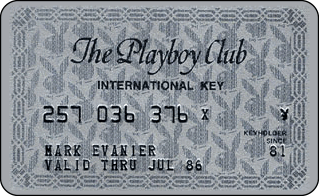
The original Los Angeles Playboy Club was opened on New Year’s Eve of 1964 at 8560 Sunset Boulevard, where the parent company had its L.A. offices. At times, a large bunny logo was projected on the side of the building. That logo was a fixture of The Strip and it also made a statement about the changing times or the new sexual freedom of Hollywood…or something like that. I never set foot in the place but I always heard it was filled with middle-aged men who came to ogle the Bunnies and to act out the fantasy that being a member made you as hip as Hef. I also heard that the parking was abominable.
In 1972, when the ABC Entertainment Center opened in Century City, the Playboy Club was relocated to a lovely room nestled under the Shubert Theater. I was given a free membership in 1981 (courtesy of Hef himself) and I couldn’t resist going a few times, partly to see the Bunnies, partly to see what the Playboy Club experience was all about…and partly to see some of the oddest dinner show entertainment in town. I dunno who booked the room or what was on their minds but the shows all evoked what I call the Springtime for Hitler look. At times, it was like they were searching for people who actually did the kind of thing Bill Murray had parodied on Saturday Night Live.
The oddest was a lady…and given her act, it’s ironic that I don’t recall her name. But I’d never heard of her before and I’m pretty sure I’ve never heard of her since. Her act was all what I call “Ego Songs.” Every one was about her: “I’ve Got the Music In Me,” “I’ve Gotta Be Me,” “This is My Life,” “My Way,” “I’ll Make My Own World,” etc. It was a variation on what the eminent philosopher Daffy Duck once called “pronoun trouble.” Between the songs, she talked about — surprise, surprise — herself and her career, as if any of that was of vital interest to us. Then for her closer, she pulled out all stops and performed what still stands as the single greatest example of Excessive Ego I have ever seen on a stage.
The great singer-songwriter Peter Allen once wrote a tune called, “Quiet Please, There’s a Lady on Stage.” It was about Judy Garland, who was recently deceased when he wrote it. She was also his mother-in-law. It’s a nice little tribute tune that quietly asks that people remember Ms. Garland (even though she is not named in the song) and to understand that despite her occasional public shortcomings, she was a great person. A very touching number.
Well, the woman at The Playboy Club closed with that song. Only she changed some lyrics and the emphasis of others and made it about herself. There’s a line that goes, “Stand for the ovation,” and she kept singing it over and over, commanding us to give her a standing ovation. People finally did, just so she’d shut up and end the show. If we hadn’t, we’d all still be there listening to her screaming out, “Stand for the ovation.” Then she took a tearful, humble bow, left the stage and came around to each table for praise, to offer autographs and to pass out business cards that told us where we could order her new album. Even the Bunnies in the room were muttering, “How can she parade around like that?”
The entertainment at The Playboy Club wasn’t all dreadful. I remember one peppy dance revue that included ten or fifteen minutes of great stand-up comedy by a young Hispanic guy I’d never heard of before. First time I ever saw Paul Rodriguez.
Food at The Playboy Club was a mixed blessing…edible but not worth the price. The best thing was the steak and it came with a lavishly-produced baked potato. Your Serving Bunny would roll a cart to your table loaded down with toppings — butter, sour cream, bacon bits, chives, salsa, etc. A very big deal was made out of having your baker dressed precisely the way you liked it. My Serving Bunnies were always disheartened that I just wanted a little butter and I sometimes let them add bacon bits not because I like them on a potato but because I couldn’t stand to disappoint a beautiful woman. The service was pretty decent except that Bunnies always had to keep dashing off to other tables to join in a chorus of “Happy birthday” and the presentation of a little bunny cake with a candle in it. Some nights, it seemed every single table there was someone’s birthday outing.
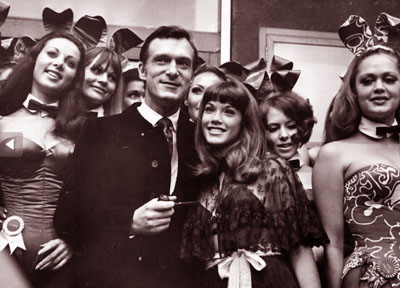
What I think killed The Playboy Clubs — or at least, that one — was that anybody could go to them…and did. There was nothing special about the clientele. You didn’t look around and see a younger, hipper throng. You saw a crowd that apart from the absence of children, could have been at the Sizzler. I once asked a Bunny I knew there how often Hef came around. She said, “About once a year for some special press conference or event.” Then, letting me in on a secret that could have cost her her tail, she told me, “He usually doesn’t stay for dinner but when he has to, he has his own chef come in and prepare his meal special.”
I started to really feel like an exploited tourist when I went there. The name, prices and “club” premise promised something more than a mediocre restaurant with bad entertainment and good-looking waitresses in what looked like uncomfortable costumes…but that’s all you got. My research failed to turn up the date when the Century City club closed and I think I know why that information is so elusive. It’s because when it happened, nobody cared.
The Viking’s Table
The Viking’s Table was a chain of all-you-can-eat buffet restaurants scattered around L.A. The main one I visited (just once) was located in Culver City. On the front, a huge, you-can’t-miss-it sign proclaimed “Smorgasboard,” which along with some artwork conveyed images of luscious carved meats, steaming trays of rotisseried fowl, hearty portions of fresh veggies. Inside, you learned it meant a steam table full of the kind of thing you’d find in your high school cafeteria and say, “Uh, I think I’ll go outside and get a sandwich from the machine.” I recall a lot of creamed items…what I guess was creamed chicken, though you could never be sure. I don’t know if the places were ever any good — I’m guessing they’d have to have been once — but by the time I got to one, forget about it. I gave up on the Viking’s Table and so did everyone else. They all closed…I thought.
Years later, going to an Egghead Software store (remember them?) on Pico at Bundy, I parked down the block and found myself in front of small restaurant that called itself The Viking’s Table and promised all I could eat for five or so bucks. As much out of curiosity as hunger, I went in and found that an Asian family was operating the place and that while the decor was travel posters of Sweden, the repast was Chinese — mostly “filler” foods like fried hollow won tons, rice and soft noodles. There was meat on the steam table but not much…and if you looked like you might be inclined to go get some, a small, Oriental child would be sent to your table to deliver a basket of bread. She would stare at you with eyes like a Walter Keane painting, silently pleading with you not to eat much…and you wouldn’t. Not because of the little girl but because there just wasn’t much there worth eating.
That one closed, too. I think they’re all gone. So are the Vikings, probably because if that’s what they have on their tables, they all starved to death.
Helms Bakery
Helms Bakery wasn’t really a restaurant but it’s my website. I can write about it here if I want to.
The Helms Bakery Building still stands on Venice Boulevard with much of its signage still intact…but inside, they bake no bread or cinnamon buns. It’s a furniture mart in there now but once upon a time beginning when Paul Helms founded the business in 1931, they made bread and sugar cookies and rolls and cupcakes and all the things that great bakeries bake. Then nice men would load them into their Helms Bakery Trucks and drive about surrounding neighborhoods, selling them to housewives and kids.
If you wanted the Helms Man to stop at your residence, you had to, first of all, put the Helms placard up in your front window…although a good Helms Man knew his territory, knew that certain homes expected him whether they had the sign up or not. He’d pull up in front and blow his distinctive whistle and you’d scurry out to his truck and buy stuff. Inside the truck, he had drawers full of cookies and donuts and rolls and I think they even carried milk and butter, though at somewhat higher prices than the nearby Safeway Market.
When I was very young, you could often find me waiting outside our home for the Helms Man. We had a rough idea of when he’d get to our street and I’d go play out front, keeping an eye out for the guy. When he approached, it was very exciting and I’d run in and get my mother. She’d buy a loaf of bread and maybe some rolls and always at least a cookie for me. Actually, the first thing our Helms Man would do when we stepped up inside his truck to make our purchases was to hand me a free cookie, usually one of their terrific sugar cookies.
Once, I got to go inside the plant thanks to an L.A. City School District program of field trips. We all piled into buses which drove us over to Culver City for a tour. Upon arrival, we were marched through the place and shown how the bread was baked, how the cookies were mixed and formed on large conveyor belts…and you couldn’t help but love how great it smelled in there. The aroma was heavenly and a whole lot better than the tuna cannery or the dairy we toured on other field trips. On the way out, each student received a small loaf of bread and a little cardboard Helms Truck.
I’m not sure why the business model was as successful for as long as it was. As mentioned, the prices on the Helms Truck were always somewhat higher than buying roughly the same things at a Safeway or Von’s, and you’d have to go to one of those markets anyway to get the other things you needed. Why not get your bread and cookies at Von’s while you were there and save a few bucks? Whatever the reason was to opt for the trucks, it seems to have faded out by the late sixties. Maybe there were fewer mothers staying at home all day or something. Maybe the quality of baked goods at the markets had improved. Whatever the cause, the whole operation shut down in 1969 and I still remember the day its trucks made their last, melancholy rounds. There was a real sense of loss when our Helms Man drove off, having sold us our rolls and sugar cookies for the last time.
The big building on Venice Boulevard sat vacant for a few years and rumors abounded as to what would become of it. In 1972, it was acquired by a real estate firm that soon began its transformation into a complex of furniture dealers…and even a little jazz club called The Jazz Bakery. Happily, as noted, they kept a lot of the old Helms Bakery decor intact and sometimes when you drive past it, you can almost imagine you’re smelling the sugar cookies, fresh out of those huge ovens.
Tracton’s
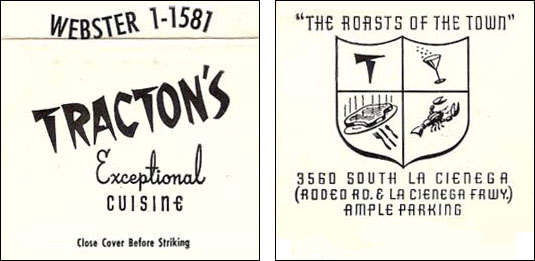
Here’s everything I remember about Tracton’s, a restaurant my family frequented for many years: It was on La Cienega down near Rodeo, across from what was then a Fedco membership department store (we were members) and is now a Target. The place was friendly inside and they served big hunks of meat. I usually had the chopped steak, which was basically just a very thick hamburger patty. I also remember an odd argument with a waitress once when my aunt asked for a doggie bag so she could take the rest of her dinner home and the waitress accused her of not having a dog. Which was true. My aunt didn’t have a dog but what business was that of the waitress?
I also remember that when Tracton’s closed, the building became one of those places that’s a different restaurant every time you drive by as one after another goes out of business. Finally, one closed down and stayed closed for a couple years until the building was torn down. And that’s all I remember about it.
Research has yielded the info that it was opened and owned by a gent named Harold “Red” Tracton who played host to all sorts of L.A. notables, mobster-types included. There was also a Tracton’s downtown and he operated the Buggy Whip restaurant near LAX (and still in business), the Salem House which was in the Farmers Market and the restaurant at the Fox Hills Country Club. Before that, he had Norm and Red’s Green Lake Cafe out in Pasadena. The most famous of all these — the Tracton’s on La Cienega that my family visited — opened there in 1956, then moved to Encino in ’78. In 1988, that place was sold and is now a Chevys Fresh Mex Restaurant. Red moved to Del Mar and opened a restaurant that’s still open (and quite successful) as Red Tracton’s, operated by his daughter Tracy. Red passed away in 1999 but his tradition of serving big hunks of meat continues.
Hamptons
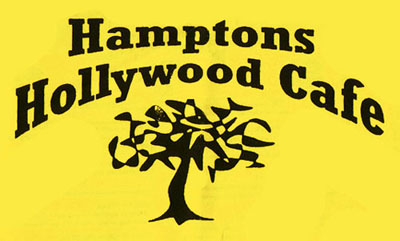
Hamptons (spelled with no apostrophe) was an upscale hamburger joint — perhaps the first one in Southern California. There were in fact two outlets of Hamptons. The original one was on Highland in Hollywood and in the spirit of full disclosure, it should be noted that the proprietor of this site was a part-owner of this one during its last few years of life. The other was out on Riverside Drive in Toluca Lake and it has now been transformed into Mo’s, with some but not all of the old Hamptons menu remaining.
Hamptons was famous as the restaurant that Paul Newman owned. That’s not exactly true but it’s also not utterly untrue. Here is how the story was told to me…
One day in the seventies, Paul Newman was having dinner with a friend of his, Ron Buck. Buck was a writer, artist and entrepreneur who had, among other ventures, built the 9000 Sunset building, as well as a trendy West Hollywood discotheque known as The Factory. He had worked without credit on several of Newman’s films, and he and the actor would later share credit for the screenplay of the 1984 Harry and Son. Buck was also great at cooking hamburgers on his backyard barbecue.
He had recently inherited an old house in which his mother had lived…on Highland Avenue in Hollywood, a few blocks south of Sunset. The other dwellings on the block were now housing real estate offices and Buck was trying to decide if he should sell the property or lease it to some business or what. Somehow, the suggestion arose that he open a gourmet burger restaurant there…a place where folks in the movie business who could afford better than Hamburger Hamlet could get one of Buck’s specialties, served with a glass of expensive wine.
The story then gets a bit murkier. Some say Newman put up the money and Buck put up the expertise and management. Since Buck was pretty wealthy, this may not be true, or it may be partially true. Some say Newman just agreed to be a frequent customer and to allow Buck to exploit that fact in publicity. Either way, the house was remodeled into a restaurant, mostly by enclosing the backyard. There was a wonderful, gnarled old tree in the middle of the yard and rather than remove it, the renovators bricked in the ground around it and allowed the tree to remain, reaching up through an opening in the newly-installed roof.
The place was named Hamptons because it was to reflect the fun and leisure of vacationing in the Long Island community known as The Hamptons. Various burgers were named for various friends and soon, it became a very “in” spot for folks who worked at nearby studios, such as Sunset-Gower or Paramount. The place didn’t do much of a dinner business but at lunchtime, it provided a welcome alternative to the fast food emporiums and taco stands of the neighborhood. At some point, it became so lucrative that Buck opened the branch on Riverside Drive in Toluca Lake. Some say that after Newman had recouped his initial investment thrice over, he withdrew whatever financial interest he had and gave full ownership to Buck. That is, if he even had any financial interest in it.
As you can see the story of Hamptons and Paul Newman’s involvement is a bit fuzzy. I vouch for none of the above, but for the fact that the two outlets of Hamptons became very popular. Once upon a time, it was impossible to get a table at lunch without a long wait. People loved the eighty varieties of burgers, including Stan’s Fantasy (with sour cream and black caviar), The Nelly Burger (creamed horseradish and bacon) and The Foggy Bottom Burger (peanut butter and sour plum jam). People also loved the little buffet that accompanied each burger, allowing you to further dress your sandwich and pile the plate with salads and side dishes. The menu did not include french fries — odd for a burger joint — but if the German Potato Salad available in the buffet wasn’t to your liking, you could order a platter of Potatoes Hamptons, which was basically hash-browns with sour cream.
I have dozens of memories of Hamptons, commencing when I worked at various studios up in Hollywood and we’d eat there once a week. It was a great place to spot celebrities and/or talk about that new screenplay. One friend of mine said it was the best place in Hollywood to meet out-of-work actresses who were waiting tables.
One time, I was lunching with the star of a TV special I was producing and we had a little trouble with a fellow at an adjoining table. He was a bit drunk and he kept banging his chair into our table and acting like it was our fault. Finally, my dining companion told him to knock it off, and the drunk stood up like he was ready to start brawling. My friend stood up to face him and the inebriated gent suddenly realized he was staring at famed dirty wrestler, Roddy “Rowdy” Piper. He immediately paid his check and left, and Roddy and I returned to our burgers.
This was in the mid-eighties. As that decade ended, so did the popularity of a lot of restaurants in Hollywood. An amazing percentage of them folded and Hamptons, while it managed to stay open, was rarely crowded. It also wasn’t very good. I believe — again, this is fourth-hand info, maybe more — Buck passed away, as did the fellow he had managing the two eateries for him. Whoever was running it tried a lot of different things, including the introduction of french fries but it didn’t help. Around 1990, I had a meal there that was so lousy, I scratched Hamptons from my list of places to go. I was not alone in this decision.
Then just a few years later, the two outlets of Hamptons were put up for sale, and were quickly purchased. One group of investors bought the one in Toluca Lake, completely renovated it and since they didn’t get custody of the name, reredubbed it “Mo’s.” The original Hamptons on Highland became Hamptons Hollywood Cafe and the group that purchased it also did a lot of remodeling, bringing in a new chef and adding new items to the menu. For some reason, they installed a “car phone” in the parking lot…a phone booth made out of an old Nash Metropolitan. And they rounded up a number of investors, one of whom was me.
I never expected to make any money off my investment and, indeed, I didn’t. The whole point of it was to be able to say to friends, “Hey, let’s have lunch at my restaurant.” Taken on that basis, it was a lot of fun. The folks who actually operated the place had a lot of good ideas, some of which were quite amusing. Since Hamptons had catered largely to an industry (show biz) crowd, they instituted an unusual pricing policy. Members of the Screen Actors Guild, Writers Guild and Directors Guild paid 10% less, while agents had to pay 10% more. The latter was meant as a joke but amazingly, there were actually diners who said, “I’m an agent. Do I really have to pay 10% more?” A few of those who asked were told yes, and they did. Wouldn’t you love to have one of those folks negotiating your deals for you?
The quality of the new Hamptons varied a lot. Sometimes, it was a great place to eat; sometimes, not. I didn’t have much to do with it except to (a) rewrite the menu to make it sillier, (b) make occasional suggestions and (c) add one menu item: The Groo Burger, based on the way my partner Sergio Aragonés likes his served…Grilled onions on top, then Mozzarella and Cheddar melted over the onions. I also had the supreme honor of having the barbecued chicken sandwich named for me and so consumed many.
But business was never too good and finally, the place was sold to a developer. For several months, it was “closed for remodeling” but no remodeling occurred. Instead, they finally tore down the house where Ron Buck’s mother had once lived, and even uprooted and removed that grand, majestic tree. The land now has on it a mixed-use structure (offices and residences) called Hampton Place. I already miss Hamptons and it’s not my investment I miss. I made a few bucks. I just always found it to be a friendly place to lunch with real good burgers and a great crowd. What more could you want?
Lawry’s
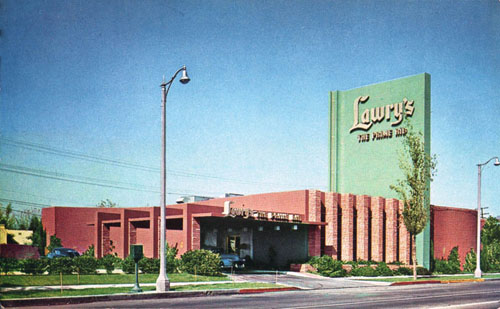
This is a bit of a cheat since Lawry’s is still very much in business but I have a certain nostalgic feeling for the building wherein I first tasted their fine, fine prime rib. Originally, Lawry’s was in a building on the east side of La Cienega. Then they outgrew that and in 1947, they moved into the above building on the west side of the boulevard. A few years ago, they rebuilt the old building and moved back into it, and the building depicted above turned into a restaurant called The Stinking Rose, where everything (including — no kidding — the ice cream) is rife with garlic.
As you probably know, when you dine at Lawry’s, your piece o’ meat is served to you by a man in a chef’s outfit with a medallion around his neck. He rolls a hefty, gleaming serving cart filled with cooked cow to your table and slices off the appropriate hunk. When Lawry’s moved across the street, the chefs rolled their carts (presumably empty) out of the old locale, then police stopped traffic on La Cienega and allowed them to push their serving stations across the boulevard and into the new building. Every time I drive up that street, I imagine a traffic sign with a little silhouette of a chef pushing a serving cart and the words, MEAT CROSSING.
Here’s a story about Lawry’s — and actually it took place at the other building, the one on the east side of La Cienega. But it could have happened at the one in the photo at the top of this item.
I was dining with a lady who liked milk and usually drank a few glasses of it at every meal. We were down near the end of our consumption. I think I had two more bites to go on my Diamond Jim Brady cut with the mashed potatoes and the creamed corn and I was beyond stuffed. I could feel seams on my skin straining under the stress. My date picked up her glass and suddenly, the bottom exploded and milk flew in every direction. Our table was covered with it.
But only for about thirty seconds. Lawry’s has spectacular service. Instantly, three or four bus boys were upon us with rags. In less time than seemed humanly possible, they’d removed every single thing on our table, dried the table, put another tablecloth in place and brought in new place settings, salt, pepper, etc. And while this was happening, unnoticed by us, our waitress hurried over to one of the gleaming carts and had the carver remake our entrees. Suddenly, it was like time had rolled back twenty minutes: In front of me was a full serving of the Diamond Jim Brady cut with the mashed potatoes and creamed corn and my date had her full dinner all over again. It transpired so rapidly that I couldn’t say, “No thanks, I couldn’t eat another bite.”
We took a few forkfuls of our refurbished dinners, then had them boxed to go. As we were leaving, we passed a man in the next booth who had seen it all, even though we hadn’t seen him. It was Jack Nicholson and he grinned that devilish smile that impressionists can never quite replicate and he said, “Nice trick there with the milk.”
The Hogie Hut
The best submarine sandwiches in town used to come from a place called The Hogie Hut which was located near (not on) the Southeast corner of La Cienega and 3rd Street. I lived about a block away for a while so I was often in there having the meatball sub, which was quite delicious and filling. Half of one could feed you for a day but alas, meatball sandwiches don’t keep well. There never seemed to be any point taking half home so I’d always overeat, stuffing down a half more than I really wanted.
Their house special was a thing called the Godfather, which was quite an array of Italian cold cuts, lettuce, tomato and provolone. All of their sandwiches were available in lengths of three feet and above for parties but the manager there told me once that most people who bought by the yard ordered the Godfather. He told me this as his staff was wheeling out the components of one that would look like it was eight feet long at some party. Of course, it was really eight foot-long sandwiches lined up and cut into two-inch segments.
I was surprised when this place went away. It seemed like an institution there on Third Street, right across from the Souplantation. There were times I’d be sitting in the Souplantation eating soup and healthier fare, looking out the window and thinking how nice a big meatball sub, bulging with meatballs and dripping cheese and marinara sauce would be.
Kelbo’s
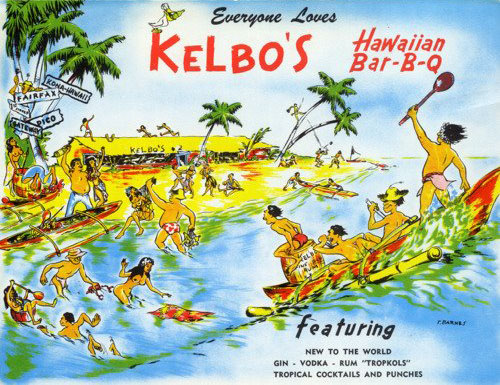
Two men, Thomas Kelley and Jack Bouck, combined the first syllables of their last names and invented Kelbo’s, a small chain of Hawaiian barbecues that were not all that Hawaiian: Burgers, barbecue meat sandwiches and some miscellaneous seafood. The concession to the islands was that every plate was garnished with a piece of pineapple and the fried shrimp was coated with coconut. They also served very sweet (but very good) barbecued ribs and had a menu of tropical drinks, some of which came flaming or served in a skull mug. About half of each restaurant was a large, dimly-lit bar that I suppose some found atmospheric. I never saw anyone there who looked like they might have been a hooker but given the mood, it wouldn’t have surprised me.
What was Hawaiian — and much of the appeal of the places — was the decor which was comprised of tiki gods, fish nets, lanterns in the shape of pineapples, and other things you could buy at any cheap patio furniture shop to suggest a real cheesy tropical motif. Some of it seemed to have come from a chain of stores that existed in L.A. in the early sixties called The Akron. A gentleman named Eli Hedley was reportedly the main designer and he also was responsible for the interior of other tropical-themed restaurants like Don the Beachcomber. I don’t know when Mr. Hedley did that voodoo that he did so well but Kelbo’s felt like a place that had been decorated in the thirties or forties and then no one changed anything.
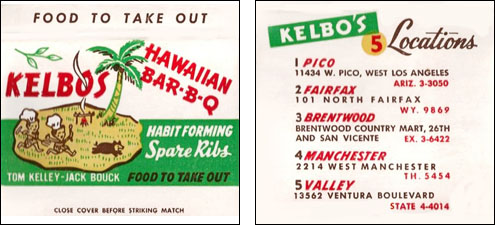
I frequented two Kelbo’s. One, on Fairfax across from CBS Television City, was torn down and there’s an outlet of The Vitamin Shoppe at that address today. It was a popular hangout for crew members who worked across the street at CBS Television City in the fifties and sixties.
The building that housed the other was over on Pico at Exposition. It still stands but has been converted into a bikini bar called Fantasy Island. I haven’t been inside since it stopped being Kelbo’s but I’ll bet they kept some of the old Hedley-selected furnishings and tiki tchotchkes.
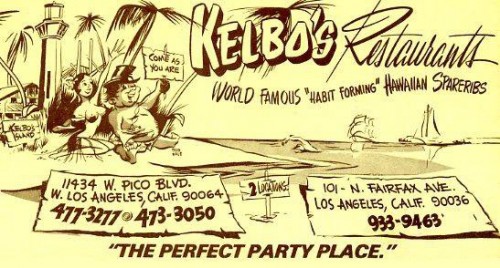
Click above to enlarge a little
One other thing that interested me about Kelbo’s was that much of its advertising art —like the drawing above — was done by a gent named Bob Hale who otherwise turned up on Los Angeles TV from time to time as a cartooning weatherman. (He was also active in Seattle where he owned a popular hobby shop that bore his name.) Hale’s drawings of a fat Hawaiian guy in native garb could be seen on Kelbo’s napkins and menus, and both of the outlets I visited had had huge Bob Hale murals on the outside, all featuring his little signature character, Sammy the Seagull. Sammy was always being drawn into his TV weathercasts, shivering or tanning himself depending on the forecast. It was said that Mr. Hale had once had a severe drinking problem and that after he quit, he lectured and illustrated pamphlets for Alcoholics Anonymous or some such group. Which always made me wonder why he had done so much work promoting a place where a lot of people just went to drink.
Schwab’s Pharmacy
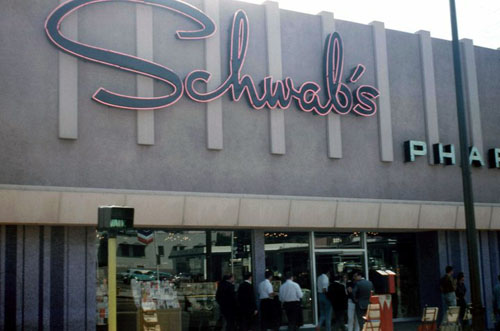
Legend has it that Lana Turner was discovered for movies as she sat at the lunch counter at Schwab’s Drugstore at Sunset and Crescent Heights, which is seen in the above picture. This is almost certainly not true. For one thing, they used to tell that story as if it had occurred at one of the other Schwab’s Pharmacies — the one further down Sunset near Doheny. When it was torn down, the legend shifted to the one at Crescent Heights. And the story probably wasn’t true even before that because Ms. Turner always told people she was spotted by a talent scout in a cafe called the Hi Hat across the street from Hollywood High School. (And even that may not be true, as others say she was found via agents and the usual submission process, and the whole story of being discovered while eating lunch was a press agent concoction.)
So then, what was the big deal about the Schwab’s at Sunset and Crescent Heights? Beats me. Seemed to me like a perfectly ordinary, poorly-stocked drugstore with a small luncheonette area. My impression is that in the sixties and maybe before, as big chain drugstores grew all over Southern California, less and less of Schwab’s business was in that area so they kept expanding the dining sections. Most of what they sold in the drug/pharmacy area seemed to be makeup such as a wanna-be actress might purchase.
But the lunch area was pleasant enough, and while you couldn’t get discovered there, you might spot a lot of people who had made it into movies and TV shows…maybe not in the star roles but it was a big hangout for actors. I don’t mean Big Stars. I mean (mostly) supporting players, including many of the “Oh, that guy” variety where you know the face but can’t place the name to save your life. I don’t think I ever ate there without seeing Dick Miller, who was so good in all those Roger Corman pictures.
During Breakfast hours, it was practically like a club — the same folks at the same tables. When Schwab’s closed down in 1983, that group began drifting from restaurant to restaurant, never managing to find a venue that was as good and actor-friendly. In the meantime, the old Schwab’s location was torn down, replaced by a shopping center built around a Virgin Megastore. Also demolished to make way for that complex was Harry’s Wood-Pit Barbecue. The Virgin is gone now too and there’s a Trader Joe’s and other businesses in its stead. They’re all probably nice places but I’d much rather have Schwab’s and Harry’s.
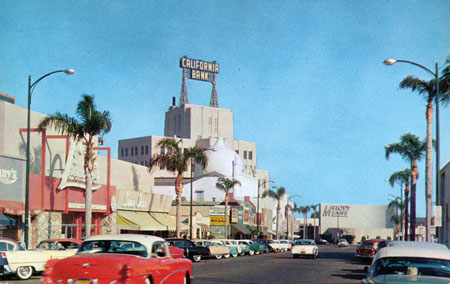
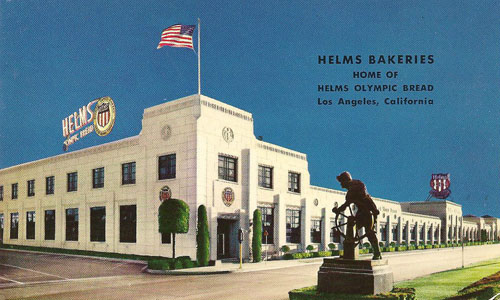

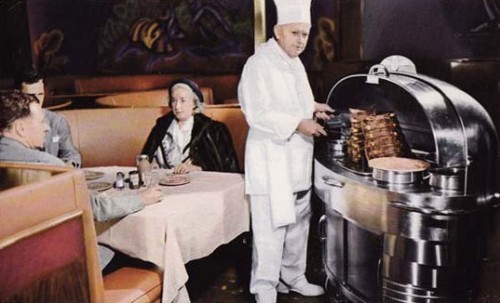
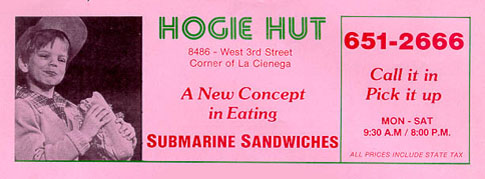






Recent Comments